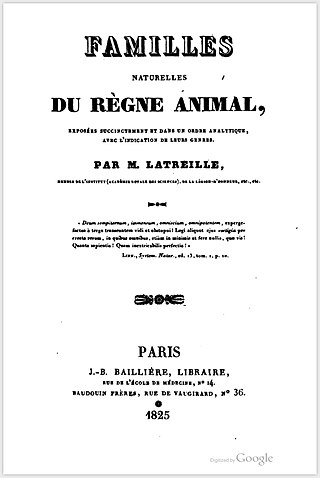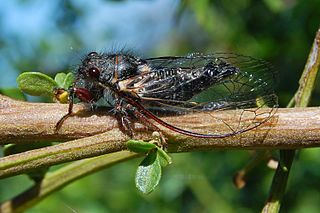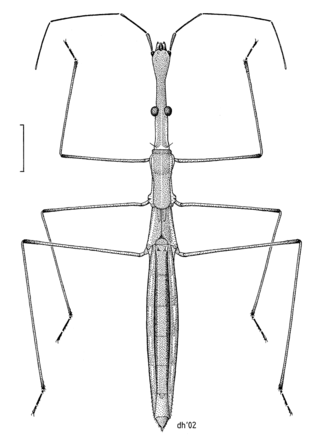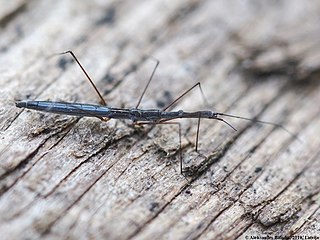
Hydrometridae is a family of semiaquatic insects, known as marsh treaders or water measurers. They have a characteristic elongated head and body which makes them resemble a yardstick for measuring the water surface.

Neotibicen tibicen, known generally as the swamp cicada or morning cicada, is a species of cicada in the family Cicadidae. It is widespread across much of the eastern and central United States and portions of southeastern Canada. There are two subspecies, N. tibicen tibicen and N. tibicen australis, with the latter replacing subspecies tibicen in portions of Florida, Georgia, and Alabama.

Tibicen is a former genus name in the insect family Cicadidae that was originally published by P. A. Latreille in 1825 and formally made available in a translation by A. A. Berthold in 1827. The name was placed on the Official Index of Rejected and Invalid Generic Names in Zoology by the International Commission on Zoological Nomenclature in 2021. Certain European cicada species that were included by some authors in this genus at the time of its suppression are now listed under genus Lyristes Horváth, 1926. Other formerly-Tibicen species are placed in the tribe Cryptotympanini and include the genera Auritibicen Lee, 2015, Hadoa Moulds, 2015 Megatibicen Sanborn and Heath, 2016, and Neotibicen Hill and Moulds, 2015.

Cicadettinae is a subfamily of cicadas in the family Cicadidae. About 230 genera and 1,200 described species are placed in the Cicadettinae.

Platypedia is a genus of cicadas in the family Cicadidae. There are more than 20 described species in Platypedia.

Neocicada is a genus of cicadas in the family Cicadidae, with about five described species.
Cacama californica is a species of cicada in the family Cicadidae. It is found in Central America and North America.
Cicadettana kansa is a species of cicada in the family Cicadidae, found in North America. The species was formerly a member of the genus Cicadetta.

Hydrometra is a genus of water measurers in the family Hydrometridae. There are more than 120 described species in Hydrometra.

Diceroprocta eugraphica is a species of cicada in the family Cicadidae. It is found in Central America and North America.
Cornuplura nigroalbata is a species of cicada in the family Cicadidae. It is found in Central America and North America.
Cornuplura is a genus of cicadas in the family Cicadidae. There are at least three described species in Cornuplura.
Hydrometra martini is a species of water measurer in the family Hydrometridae. It is found in North America.
Beameria is a genus of cicadas in the family Cicadidae. There are at least three described species in Beameria.
Diceroprocta texana is a species of cicada in the family Cicadidae. It is found in Central America and North America.
Diceroprocta marevagans is a species of cicada in the family Cicadidae. It is found in Central America and North America.
Cacama collinaplaga is a species of cicada in the family Cicadidae. It is found in North America.
Cicadettana camerona is a species of cicada in the family Cicadidae found in North America. The species was formerly a member of the genus Cicadetta.

Lyristes is a genus of cicadas from Europe and the Middle East. It was described by G. Horvath in 1926.

Hydrometra gracilenta, the lesser water-measurer, is a species of aquatic bugs in the family Hydrometridae.










